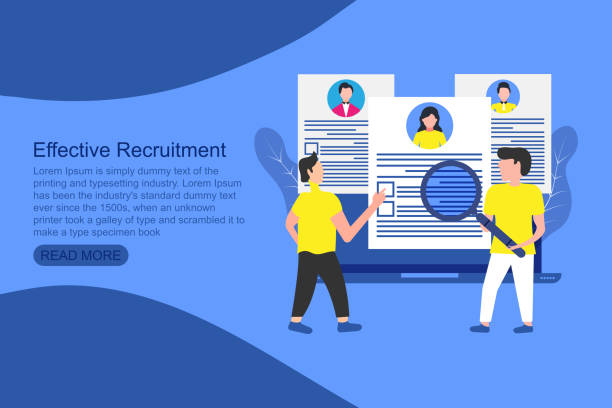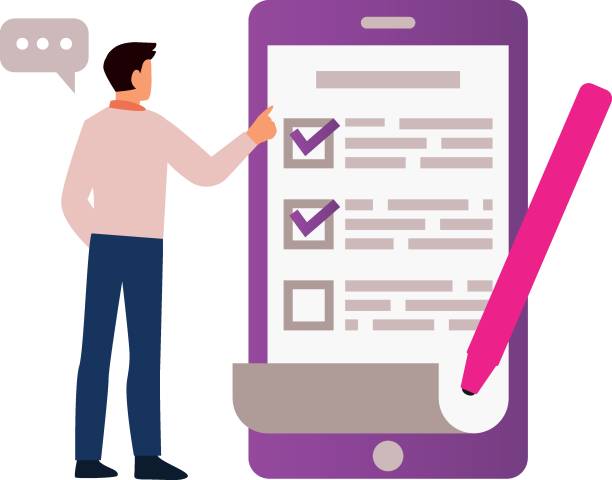The Importance of Multilingual Website Design in Today’s World

In the age of #globalization and #uninterrupted_communication, limiting your business to a single language and culture is no longer considered a smart choice.
#Multilingual_website_design literally opens new doors to international markets, enabling businesses to connect with a wider audience worldwide.
This approach not only increases brand accessibility and #visibility but also fosters trust and loyalty among potential customers.
When visitors to your website can view content in their native language, it creates a very positive user experience, which is a key factor in converting visitors into customers.
A multilingual website sends your message beyond geographical and cultural boundaries, creating a stronger presence in the global market. Neglecting this dimension can mean losing a significant market share.
This is a strategic step for any brand seeking sustainable growth and development on an international scale.
Technically and content-wise, implementing such a system requires precise knowledge and planning.
How much does losing business leads due to an unprofessional website cost you? Solve this problem forever with professional corporate website design by Rasaweb!
✅ Increase credibility and trust of potential customers
✅ Easier acquisition of new business leads
⚡ Get a free consultation now!
Technical Fundamentals of Multilingual Website Design and Choosing the Right Structure

When planning for #multilingual_website_design, one of the first and most crucial technical decisions is choosing the appropriate structure for language addressing.
This decision will directly impact #SEO, #content_management, and #user_experience.
The three main approaches include subdomains, subdirectories, and country code top-level domains (ccTLDs).
Using subdirectories like example.com/en/ or example.com/fa/ is generally preferred for #SEO, as they inherit all authority signals from the main domain and are simpler to manage.
Subdomains like en.example.com or fa.example.com are also viable options, but Google might interpret them as relatively separate entities, though this can be resolved with correct hreflang settings.
ccTLDs like example.fr or example.de offer the strongest geographical signal but come with significantly higher costs and management complexity. The choice of each of these structures should be made considering business goals, budget, and technical resources.
Correct implementation of these structures is vital for the success of a multilingual website and requires deep technical knowledge in #website_development.
Understanding the differences and advantages of each approach is the first step in building a strong and efficient platform.
Challenges and Opportunities in Multilingual Website Design

#Multilingual_website_design not only provides countless opportunities for market expansion but also brings its own set of challenges.
Among the most important challenges are content management for different languages, ensuring translation accuracy, and cultural localization.
Mere word translation is not enough; content must align with the #culture and #preferences of the target audience in each geographical region.
This includes dates, currency, images, and even writing tone.
Furthermore, maintaining and updating multilingual content can be very complex and time-consuming, especially if a suitable content management system has not been considered.
However, overcoming these challenges creates great opportunities; including a significant increase in #access_to_new_audiences, improved international SEO, and strengthened global #branding.
A well-managed multilingual website can quickly become a powerful tool for business growth and development at an international level. This process is a long-term investment with significant returns.
Below is a comparative table of the advantages and disadvantages of multilingual website design:
| Advantages | Disadvantages/Challenges |
|---|---|
| Increased access to global markets and new audiences | Complexity of content management and updates |
| Improved international SEO and search engine rankings | Need for accurate and high-quality translation and localization |
| Enhanced trust and user experience by providing content in the native language | Increased maintenance and development costs |
| Increased conversion rate of visitors to customers | Technical complexities in implementing hreflang and URL structure |
| Creation of a professional and international brand image | Need for specialized knowledge in international SEO |
Best Practices for International SEO in Multilingual Website Design

One of the most important aspects of #multilingual_website_design that is often overlooked is #international_SEO.
Without a proper SEO strategy, even the best translations and localized content may never be found by the target audience.
The key element in multilingual SEO is the correct use of the #hreflang tag.
This tag helps search engines like #Google to identify and serve the correct version of a page based on the user’s language and geographical region.
Incorrect hreflang implementation can lead to issues such as #duplicate_content, which harms site rankings.
In addition to hreflang, creating a separate #sitemap for each language and ensuring all translated pages are included in it is important. Optimizing keywords for each language is also essential, as keywords may have different meanings and search volumes in different languages.
Building high-quality backlinks from local websites in each target country can also significantly help improve site authority and ranking.
All these actions are aimed at increasing the visibility of a #multilingual_website in search results for users from different regions and directly contribute to its success.
Tired of losing customers due to poor e-commerce website design? With Rasaweb, solve this problem forever!
✅ Increase sales and visitor-to-customer conversion rate
✅ Smooth and engaging user experience for your customers⚡ Get a free consultation
Content Management in Multilingual Platforms

Content management in a #multilingual_platform goes beyond mere text translation; it involves the organized creation and maintenance of content for various languages and cultures.
Choosing a #Content_Management_System (CMS) with robust multilingual capabilities is the first and vital step.
Systems like #WordPress with plugins such as WPML or Polylang, as well as enterprise CMSs like Drupal or Joomla, provide easy management of translations, publishing localized content, and creating workflows for translation approval.
It is essential for the content team to collaborate with professional translators and cultural localizers to ensure the accuracy and credibility of content in each language. In addition to text, images, videos, and other media elements should also be localized to suit different cultures.
A strong content management strategy helps reduce human errors, save time and cost, and ensure brand consistency across all languages.
Implementing an #organized_process for updating and archiving multilingual content is also essential to maintain website efficiency and accuracy in the long term.
Is Multilingual Website Design Always the Best Solution? Examining Questionable Points

While the advantages of #multilingual_website_design are evident, the question arises whether this approach is always the best solution for every business. The answer is not always positive.
For very small businesses or startups with limited resources, the initial investment and maintenance costs of a multilingual website can be challenging.
Furthermore, if your primary target market is only a specific geographical region with a common language, implementing multiple languages may not be necessary and could even lead to unnecessary complexities. Sometimes, focusing on optimizing a single-language website for a specific market yields greater returns.
The important question is whether your international audience is large enough to justify investing in #multilingual_website_development? Does your product or service truly have globalization potential? A thorough #market_analysis and #ROI_evaluation are vital before proceeding with the design of a #multilingual_site.
For some businesses, starting with a strong single-language website and then expanding to other languages in later stages might be a more logical approach.
This decision should be made based on data and the long-term business strategy, not merely by following a trend.
Latest Trends in Multilingual Website Design and Their Impact on Business

The #multilingual_website_design market is evolving, and new trends are emerging daily that can influence how businesses interact with international audiences.
One of the most important trends is the use of #Artificial_Intelligence and #Machine_Learning for content translation and localization.
AI-powered tools can significantly increase translation speed while providing acceptable quality, though they still require human review.
Another trend is the increased focus on personalized #User_Experience (UX), where the website automatically displays language and content relevant to the user’s geographical location and preferences. This is achieved using geolocation detection capabilities and cookies.
Furthermore, the importance of #voice_SEO for various languages is growing, as more users utilize voice search to find information.
Adapting website design to different devices (responsive design) and ensuring fast website performance in various regions worldwide are also critical trends affecting #multilingual_platforms.
Understanding and implementing these trends can help businesses outperform their competitors and provide a better user experience.
The table below compares common approaches for language addressing in a multilingual site:
| Approach | Advantages | Disadvantages | Example |
|---|---|---|---|
| Subdirectories | Best for SEO (shared domain authority), easier management | May have a weaker geographical signal | example.com/fa/ |
| Subdomains | Easier separation in hosting, independent management | May inherit less SEO authority from the main domain | fa.example.com |
| Country Code Top-Level Domains (ccTLDs) | Strongest geographical signal, complete separation | High cost, complex management, need for multiple domains | example.ir |
Success Stories in Multilingual Website Design

Seeing successful examples of #multilingual_website_design can be inspiring and demonstrate how businesses have used this strategy for growth and expansion.
Many large international companies such as #Amazon, #Google, and #Airbnb are prime examples of multilingual websites with excellent design.
By providing services and content in various languages, these companies have managed to penetrate new markets and gain customer loyalty worldwide.
For example, Airbnb, by offering its platform in over 60 languages, has provided access to millions of users in various countries, thus becoming a global giant in the tourism industry. This success is not limited to text translation but also includes full localization of the booking experience, customer support, and even displaying local currencies.
These success stories prove that investing in #multilingual_site_development is not just an expense, but a #strategic_investment for sustainable growth and achieving a leadership position in the global market.
The key to these successes lies in attention to detail, a deep understanding of the target audience, and flawless implementation of multilingual technologies.
Does your current website convert visitors into customers or drive them away? With professional corporate website design by Rasaweb, solve this problem forever!
✅ Build strong credibility and branding
✅ Attract target customers and increase sales
⚡ Get a free consultation now!
Choosing the Right Tools and Platforms for Multilingual Website Design

Choosing the right tools and #platforms for #multilingual_website_design is a crucial step that can determine the success or failure of the project.
Content Management Systems (CMS) like #WordPress, #Joomla, and #Drupal are popular options that, with multilingual plugins and modules, enable the creation of an international website.
For WordPress, plugins such as WPML and Polylang are among the most powerful multilingual tools, offering content translation, string management, and SEO settings.
For larger and enterprise websites, custom CMSs or platforms like Sitecore and Adobe Experience Manager offer more advanced capabilities for managing multilingual content and personalizing the user experience. In addition to CMS, translation tools like Google Translate API, DeepL, and professional human translation services play a significant role in the quality of multilingual content.
Also, SEO analysis tools like Google Search Console and Ahrefs are crucial for monitoring international SEO performance and identifying potential issues.
Choosing a combination of these tools that suits your business’s needs, budget, and scale helps create an efficient and successful #multilingual_website.
The Future of Multilingual Website Design and Upcoming Trends

The future of #multilingual_website_design is intertwined with rapid advancements in technology, especially in #Artificial_Intelligence and #Natural_Language_Processing (NLP).
It is expected that machine translation tools will become increasingly smarter, able to provide translations nearly human-quality with a deeper understanding of context and cultural nuances.
This will make the #localization process faster and more cost-effective.
Furthermore, #user_experience_personalization based on language, geographical location, and even accent will become a standard feature of multilingual websites.
Increased use of #blockchain_technology for digital identity management and international payments may also impact the future functioning of multilingual sites. A greater focus on content #accessibility for individuals with different abilities across various languages is another important trend.
Ultimately, the concept of #multicultural_website_design, rather than merely multilingual, will gain more importance; meaning websites will be designed not only in different languages but also considering cultural, visual, and even interactive differences, to provide a fully localized experience for each user.
These developments have transformed #multilingual_website_design into a dynamic and exciting field.
Frequently Asked Questions
| Question | Answer |
|---|---|
| What is multilingual website design? | The process of building a website whose content is available to users in more than one language. |
| Why should I make my website multilingual? | To reach a larger global audience, improve user experience for non-native speakers, and increase sales or engagement. |
| What are the methods for implementing a multilingual site? | Using subdomains, subdirectories, or URL parameters, or using different Top-Level Domains (TLDs) for each language. |
| Which method is better for SEO? | Generally, using subdirectories (e.g., example.com/fa/) is recommended for SEO, as they share the main domain’s authority. |
| What is the hreflang tag and what is its use? | The hreflang tag is an HTML attribute that helps search engines understand which version of a page is appropriate for a specific language or region. |
| Is machine translation sufficient for multilingual website content? | Usually no. Professional translation and content localization are essential to provide a good user experience and maintain credibility. |
| What does Localization mean? | The process of adapting content, design, and website functionality to the culture, language, currency, and other specific characteristics of a target region or country. |
| What is the importance of language selection in multilingual website design? | Users should be allowed to easily select their preferred language, usually through a clear button or menu in the site’s header. |
| What challenges exist in multilingual website design? | Managing content in different languages, maintaining design and user experience consistency, multilingual SEO, and translation and maintenance costs. |
| What features does a suitable Content Management System (CMS) for a multilingual site have? | It should allow for easy content management in various languages, support multilingual URL structures, and have plugins related to translation and localization. |
And other services of Rasaweb Advertising Agency in the field of advertising:
Smart Advertorial: An innovative service for increasing digital branding through dedicated programming.
Smart Website Development: Transform customer acquisition with marketing automation.
Smart Customer Journey Map: A specialized service for increasing website traffic based on marketing automation.
Smart Social Media: A professional solution for increasing sales with a focus on intelligent data analysis.
Smart Direct Marketing: Designed for businesses seeking to increase sales through the use of real data.
And over hundreds of other services in the field of online advertising, advertising consulting, and organizational solutions
Online Advertising | Advertising Strategy | Advertorial
References
- Multilingual Website Design Guide – Comprehensive Guide
- Advantages of a Multilingual Site – Arian Host
- How to Design a Multilingual Site – Tavansazan
- Tips for Multilingual Website Design – Web Doni
? Rasaweb Afarin, specializing in digital marketing solutions, helps your business achieve its goals. We are your best partner for success in the digital world, covering WordPress website design, SEO optimization, social media management, and online advertising campaigns. Contact us today for a free consultation and to learn about our services!
📍 Tehran, Mirdamad Street, next to Central Bank, Kazeroun South Alley, Ramin Alley, No. 6



